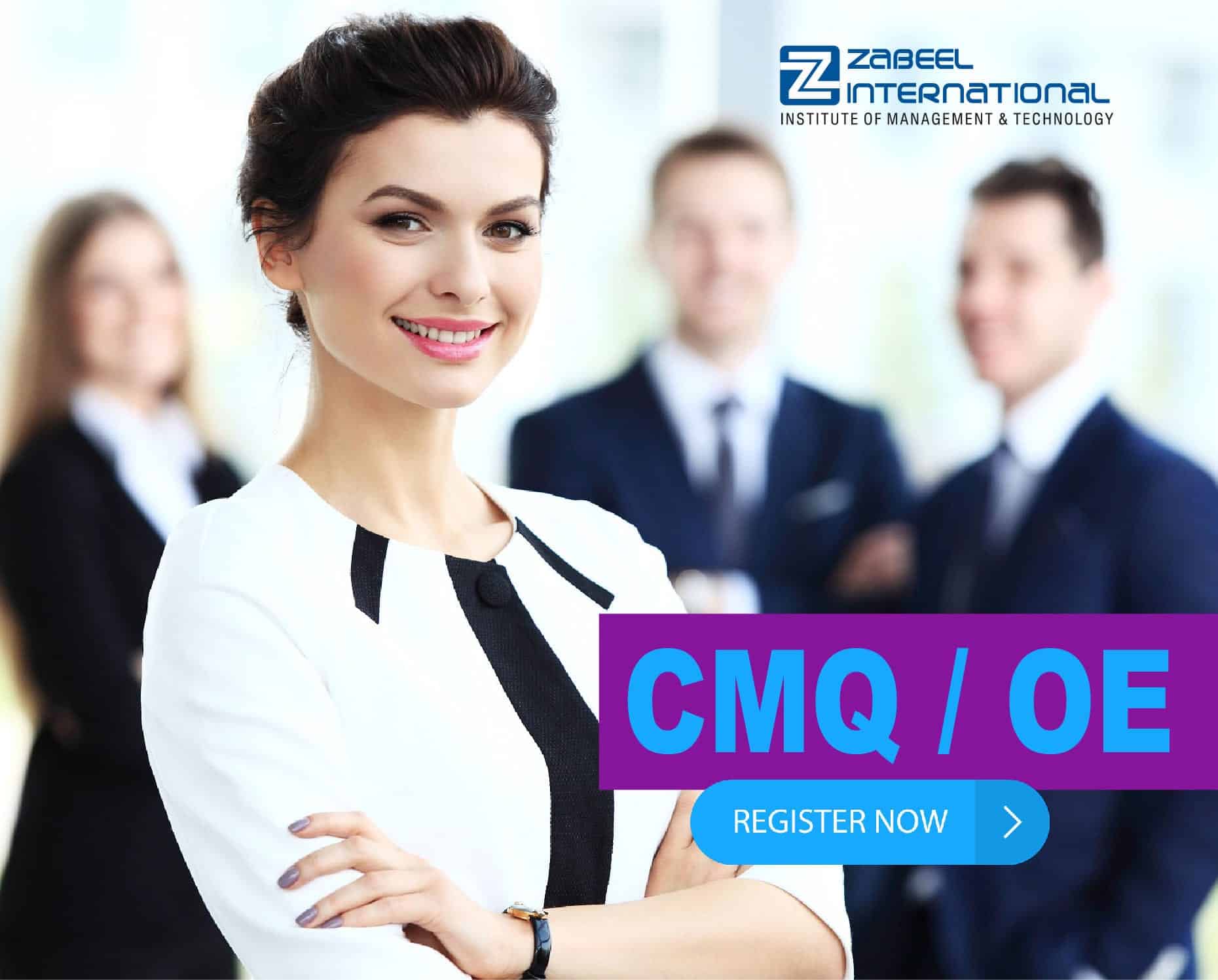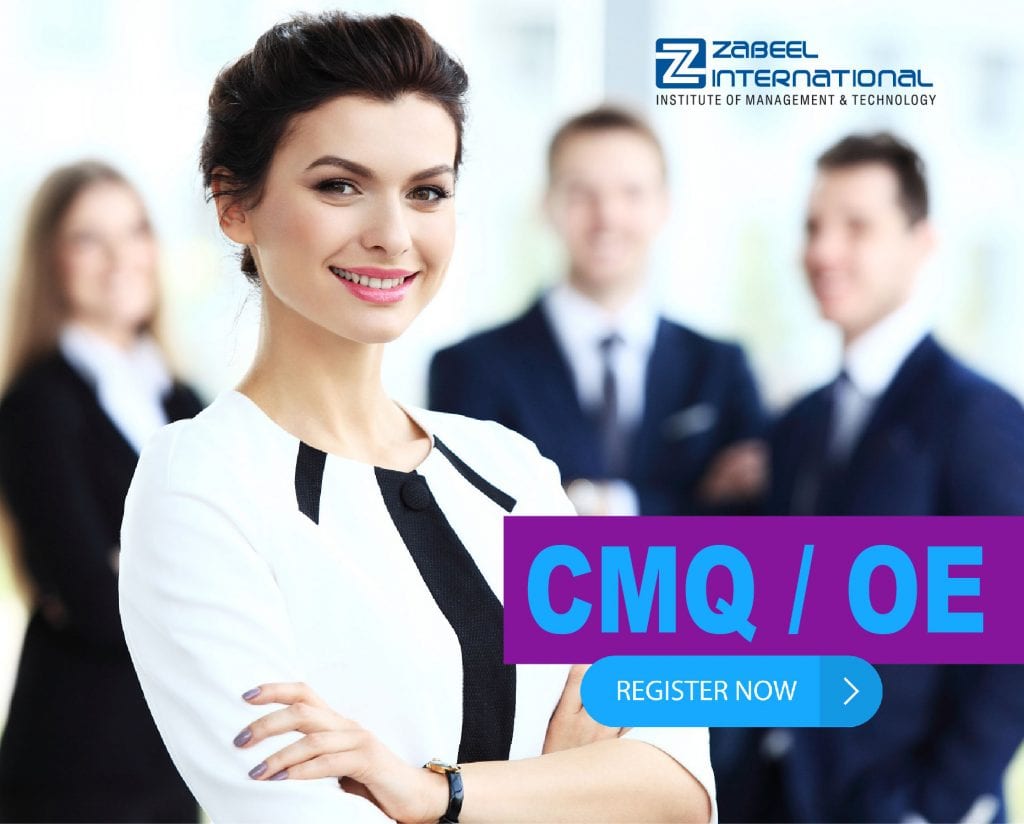Search for your desired courses here
CMQ/OE (CERTIFIED MANAGER OF QUALITY)
Overview of CMQ/OE Certification training course:
The CMQ OE stands for Certified Manager of Quality/ Organizational Excellence is a prestigious ASQ certification. Professionals with CMQ certification leads and champions process improvement initiatives everywhere from small businesses to multinational corporations – that can have regional or global focus in a variety of service and industrial settings. CMQ OE quality Management Certifiacation facilitates and leads team efforts to establish and monitor customer/supplier relations, supports strategic planning and deployment initiatives, and helps develop measurement systems to determine organizational improvement.
Zabeel offer professional and high-level practical session, and IATA Hotel and Hospitality Management Course in Dubai, Sharjah & Abu Dhabi
Learning Outcome of CMQ/OE Certification training course :
CMQ/OE Certification training course provides improved knowledge, skills, and abilities qualify you for more positions within modern business industries that require demonstrated competency in quality management.
CMQ Certification from ASQ is considered a mark of quality excellence in many industries. It helps you advance your career, and boosts your organization’s bottom line through your mastery of quality skills. Becoming certified as a Manager of Quality/Organizational Excellence confirms your commitment to quality and the positive impact it will have on your organization.
Who needs the CMQ/OE Certification training course?
- CMQ/OE Certification training course is required for professionals who face the challenges of helping their organization focus and deploy common goals, strategies, plans and customer requirements.
- CMQ/OE Certification training course is recommended for Directors, managers, supervisors and team leaders who are required to apply a fact-based design, control and accelerated-improvement process that achieves performance results.
- New and experienced people in quality who want to use the QM framework and proven approaches and tools to be more effective on the job can go for CMQ/OE Certification.
Detailed Course Content of CMQ/OE Certification training course:
I. Leadership (25 Questions)
A. Organizational Structures
Define and describe organizational designs (i.e., matrix, flat, and parallel) and the effect that a hierarchical management structure can have on an organization. (Apply)
B. Leadership Challenges</style=>
- Roles and responsibilities of leaders
Describe typical roles, responsibilities, and competencies of people in leadership positions and how those attributes influence an organization’s direction and purpose. (Analyze)
- Roles and responsibilities of managers
Describe typical roles, responsibilities, and competencies of people in management positions and how those attributes contribute to an organization’s success. (Analyze)
- Change management
Use various change management strategies to overcome organizational roadblocks and achieve desired change levels, and review outcomes for effectiveness. Define and describe factors that contribute to an organization’s culture. (Evaluate)
- Leadership techniques
Develop and implement techniques that motivate employees and sustain their enthusiasm. Use negotiation techniques to enable parties with different or opposing outlooks to recognize common goals and work together to achieve them. Determine when and how to use influence to resolve a problem or move a project forward. (Create)
- Empowerment
Apply various techniques to empower individuals and teams. Identify typical obstacles to empowerment and appropriate strategies for overcoming them. Describe and distinguish between job enrichment and job enlargement, job design and job tasks. (Apply)
C. Teams and Team Processes
- Types of teams
Identify different types of teams and their purpose, including process improvement, self-managed, temporary or ad hoc (special project), and work groups or work cells. (Understand)
- Stages of team development
Define and describe the classic stages of team development: forming, storming, norming, and performing. (Apply)
- Team-building techniques
Apply basic team-building steps such as using ice-breaker activities to enhance team introductions and membership, developing a common vision and agreement on team objectives, and identifying and assigning specific roles on the team. (Apply)
- Team roles and responsibilities
Define and describe typical roles related to team support and effectiveness, such as facilitator, leader, process owner, champion, project manager, and contributor. Describe member and leader responsibilities with regard to group dynamics, including keeping the team on task, recognizing hidden agendas, handling disruptive behavior, and resolving conflict. (Analyze)
- Team performance and evaluation
Evaluate team performance in relation to established metrics to meet goals and objectives. Determine when and how to reward teams and celebrate their success. (Evaluate)
D. ASQ Code of Ethics
Identify and apply behaviors and actions that comply with this code. (Apply)
II. Strategic Plan Development and Deployment (18 Questions)
A. Strategic Planning Models
Define, describe, and use essential elements of strategic planning models, including how mission, vision, and values as guiding principles relate to the plan. (Apply)
B. Business Environment Analysis
- SWOT analysis
Analyze an organization’s strengths, weaknesses, opportunities, and threats, and develop and prioritize actions to respond to that analysis. Identify and analyze risk factors that can influence strategic plans. (Analyze)
- Market forces
Define and describe various forces that drive strategic plans, including existing competition, the entry of new competitors, rivalry among competitors, the threat of substitutes, bargaining power of buyers and suppliers, current economic conditions, and how well the organization is positioned for growth and changing customer expectations. (Apply)
- Stakeholder analysis
Identify and differentiate various internal and external stakeholders, as well as their perspectives, needs, and objectives, to ensure that the organization’s strategic goals are aligned with those of the stakeholders. (Analyze)
- Technology
Describe how technological changes can have long- and short-term influences on strategic planning. (Understand)
- Internal capability analysis
Identify and describe the effects that influence an organization’s internal capabilities: human resources, facilities capacity, and operational capabilities. Analyze these factors in relation to strategy formation. (Analyze these factors in relation to strategy formation. (Analyze)
- Legal and regulatory factors
Define and describe how these factors can influence strategic plans. (Understand)
C. Strategic Plan Deployment
- Tactical plans
Identify essential characteristics of tactics: specific, measurable, attainable, relevant, time-specific, and linked to strategic objectives. Evaluate proposed plans to determine whether they meet these criteria. (Evaluate)
- Resource allocation and deployment
Evaluate current resources to ensure they are available and deployed in support of strategic initiatives. Identify and eliminate administrative barriers to new initiatives. Ensure that all internal stakeholders understand the strategic plan and have the competencies and resources to carry out their responsibilities. (Evaluate)
- Organizational performance measurement
Develop these measures, ensure they are aligned with strategic goals, and use them to evaluate the organization against the strategic plan. (Evaluate)
- Quality in strategic deployment
Support strategic plan deployment by applying continuous improvement and other quality initiatives to drive organizational performance outcomes. (Create)
III. Management Elements and Methods (30 Questions)
A. Management Skills and Abilities
- Principles of management
Define and apply basic management principles such as planning, leading, delegating, controlling, organizing, and allocating resources. (Apply)
2. Management theories and styles
Define and describe management theories such as scientific, organizational, behavioral, learning, systems thinking, and situational complexity. Define and describe management styles such as autocratic, participative, transactional, transformational, management by fact, coaching, and contingency approach. Describe how management styles are influenced by an organization’s size, industry sector, culture, and competitors. (Apply)
3. Interdependence of functional areas
Describe the interdependence of an organization’s areas (human resources, engineering, sales, marketing, finance, research and development, purchasing, information technology, logistics, production, and service) and how those dependencies and relationships influence processes and outputs. (Understand)
4. Human resources (HR) management
Apply HR elements in support of ongoing professional development: setting goals and objectives, conducting performance evaluations, developing recognition programs, ensuring that succession plans are in place where appropriate. Develop quality-supportive responsibilities to include in job descriptions for positions throughout the organization. (Apply)
5.Financial management
Read, interpret, and use various finance tools including income statements, balance sheets, and product/service cost structures. Manage budgets and use the language of cost and profitability to communicate with senior management. Use potential return on investment (ROI), estimated return on assets (ROA), net present value (NPV), internal rate of return (IRR), and portfolio analysis to analyze project risk, feasibility, and priority. (Analyze)
6. Risk management
Identify the kinds of risk that can occur throughout the organization, from such diverse processes as scheduling, shipping/receiving, financials, production and operations, employee and user safety, regulatory compliance and changes. Describe and use risk control and mitigation methods: avoidance, reduction, prevention, segregation, and transfer. (Apply)
7. Knowledge management (KM)
Use KM techniques in identifying core competencies that create a culture and system for collecting and sharing implicit and explicit knowledge among workers, customers, competitors, and suppliers. Capture lessons learned and apply them across the organization to promote best practices. Identify typical knowledge-sharing barriers and how to overcome them. (Apply)
B. Communication Skills and Abilities
- Communication techniques
Define and apply various modes of communication used within organizations, such as, verbal, nonverbal, written, and visual. Identify factors that can inhibit clear communication and describe ways of overcoming them. (Apply)
- Interpersonal skills
Develop skills in empathy, tact, friendliness, and objectivity. Use open-minded and nonjudgmental communication methods. Develop and use a clear writing style, active listening, and questioning and dialog techniques that support effective communication. (Apply)
- Communications in a global economy
Identify key challenges of communicating across different time zones, cultures, languages, terminology, and business practices, and identify ways of overcoming them. (Understand)
- Communications and technology
Identify how technology has affected communications, including improved information availability, its negative influence on interpersonal communications, and the new etiquette for e-communications. Use appropriate communication methods to deliver different kinds of messages in a variety of situations. (Apply)
C. Project Management
- Project management basics
Use project management methodology and ensure that each project is aligned with strategic objectives. Define the different phases of a project: initiation, planning, execution, monitoring and controlling, and closure. Recognize the importance of keeping the project on time, and within budget. (Apply)
- Project planning and estimation tools
Use tools such as risk assessment, benefit-cost analysis, critical path method (CPM), Gantt chart, PERT, and work breakdown structure (WBS) to plan projects and estimate related costs. (Apply)
- Measure and monitor project activity
Use tools such as cost variance analysis, milestones, and actual vs. planned budgets to monitor project activity against project plan. (Evaluate)
- Project documentation
Use written procedures and project summaries to document projects. (Apply)
D. Quality System
- Quality mission and policy
Develop and monitor the quality mission and policy and ensure that it is aligned with the organization’s broader mission. (Create)
- Quality planning, deployment, and documentation
Develop and deploy the quality plan and ensure that it is documented and accessible throughout the organization. (Create)
- Quality system effectiveness
Evaluate the effectiveness of the quality system using various tools: balanced scorecard, internal audits, feedback from internal and external stakeholders, skip-level meetings, warranty data analytics, product traceability and recall reports, and management reviews. (Evaluate)
E. Quality Models and Theories
- Performance excellence models
Define and describe common elements and criteria of performance excellence models such as the Malcolm Baldrige National Quality Award (MBNQA), Excellence Canada, and the European Excellence Award (EFQM). Describe how their criteria are used as management models to improve processes at an organization level. (Understand)
- ISO quality management standards
Define and describe how the ISO 9001 standards can be used to support quality management systems. (Understand)
- Other quality methodologies
Describe and differentiate methods such as total quality management (TQM), continuous improvement, and benchmarking. (Apply)
- Quality philosophies
Describe and apply basic methodologies and theories proposed by quality leaders such as Shewhart, Deming, Juran, Crosby, Feigenbaum, and Ishikawa. (Apply)
IV. Quality Management Tools (30 Questions)
A. Problem-Solving Tools
- The seven classic quality tools
Select, interpret, and evaluate output from these tools: Pareto charts, cause and effect diagrams, flowcharts, control charts, check sheets, scatter diagrams, and histograms. (Evaluate)
- Basic management and planning tools
Select, interpret, and evaluate output from these tools: affinity diagrams, tree diagrams, process decision program charts (PDPCs), matrix diagrams, prioritization matrices, interrelationship digraphs, and activity network diagrams. (Evaluate)
- Process improvement tools
Select, interpret, and apply tools such as root cause analysis, PDCA, Six Sigma DMAIC (define, measure, analyze, improve, control), and failure mode and effects analysis (FMEA). (Evaluate)
- Innovation and creativity tools
Use various techniques and exercises for creative decision making and problem solving, including brainstorming, mind mapping, lateral thinking, critical thinking, the 5 whys, and Design for Six Sigma (DFSS). (Apply)
- Cost of quality (COQ)
Define and distinguish between prevention, appraisal, internal, and external failure cost categories and evaluate the impact that changes in one category will have on the others. (Evaluate)
B. Process Management
- Process goals
Describe how process goals are established, monitored, and measured and evaluate their impact on product or service quality. (Evaluate)
- Process analysis
Use various tools to analyze a process and evaluate its effectiveness on the basis of procedures, work instructions, and other documents. Evaluate the process to identify and relieve bottlenecks, increase capacity, improve throughput, reduce cycle time, and eliminate waste. (Evaluate)
- Lean tools
Identify and use lean tools such as cycle-time reduction, 5S, just-in-time (JIT), kanban, value stream mapping, single-minute exchange of die (SMED), poke-yoke, kaizen, and overall equipment effectiveness (OEE). (Apply)
- Theory of constraints (TOC)
Define key concepts of TOC: systems as chains, local vs. system optimization, physical vs. policy constraints, undesirable effects vs. core problems, and solution deterioration. Classify constraints in terms of resources and expectations as defined by measures of throughput, inventory, and operating expense. (Understand)
C. Measurement: Assessment and Metrics
- Basic statistical use
Use techniques such as the goal- question-metric (GQM) model and others to identify when, what, and how to measure projects and processes. Describe how metrics and data gathering methods affect resources and vice versa. (Apply)
- Sampling
Define and describe basic sampling techniques such as random and stratified. Identify when and why sampling is an appropriate technique to use. (Understand)
- Statistical analysis
Calculate basic statistics: measures of central tendency (mean, median, mode), and measures of dispersion (range, standard deviation, and variance). Identify basic distribution types (normal, bimodal, skewed) and evaluate run charts, statistical process control (SPC) reports, and other control charts to make data-based decisions. (Evaluate)
- Measurement systems analysis
Define basic measurement terms: accuracy, precision, bias, and linearity. Understand the difference between repeatability and reproducibility in gauge R&R studies. (Understand)
- Trend and pattern analysis
Interpret graphs and charts to identify cyclical, seasonal, and environmental data trends. Evaluate control chart patterns to determine shifts and other trend indicators in a process. (Evaluate)
- Process variation
Analyze data to distinguish between common and special cause variation. (Analyze)
- Process capability
Recognize process capability (Cp and Cpk,) and performance indices (Pp and Ppk). (Understand)
- Reliability terminology
Define and describe basic reliability measures: mean time between failures (MTBF) and mean time to repair (MTTR). Understand the value of reliability for estimating the probability of being able to meet requirements or specifications, typically for a specific period of time. NOTE: Reliability calculations will not be tested. (Understand)
- Qualitative assessment
Identify subjective measures such as verbatim comments from customers, observation records, and focus group output. Describe how they differ from objective measures, and determine when measurements should be captured in categories rather than numeric value. (Analyze)
V. Customer-Focused Organizations (17 Questions)
A. Customer Identification and Segmentation
- Internal customers
Define and describe the impact an organization’s treatment of internal customers will have on external customers. Develop methods for energizing internal customers to improve products, processes, and services and evaluate the results. (Evaluate)
- External customers
Define external customers and describe their impact on products and services. Develop strategies for working with them and integrating their requirements and needs to improve products, services, and processes. (Evaluate)
- Customer segmentation
Define and describe the process of customer segmentation and its impact on aligning service and delivery to meet customer needs. (Evaluate)
B. Customer Relationship Management
- Customer needs
Use quality function deployment (QFD) to analyze customer needs in relation to products and services offered. Use the results of the analysis to prioritize future development in anticipation of changing customer needs. (Analyze)
- Customer satisfaction and loyalty
Develop systems to capture positive and negative customer perceptions and experiences using tools such as voice of the customer, listening posts, focus groups, complaints and warranty data, surveys, and interviews. Use customer value analysis to calculate the financial impact of existing customers and the potential results of losing those customers. Develop corrective actions and proactive methods to improve customer satisfaction, loyalty, and retention levels. (Create)
- Customer service principles
Develop and deploy strategies that support customer service principles: courtesy, politeness, smiles, cheerfulness, attention to detail, active listening, empathy, rapid response, and easy access for information and service. (Apply)
- Multiple and diverse customer management
Establish and monitor priorities to avoid or resolve conflicting customer requirements and demands. Develop methods and systems for managing capacity and resources to meet the needs of multiple customers. Describe the impact that diverse customer groups can have on all aspects of product and service development and delivery. (Evaluate)
V. Supply Chain Management (15 Questions)
- Supplier Selection
Define, develop, and use criteria for selecting suppliers, including internal rating programs and external certification standards. Assess and manage the impact these programs can have on various internal processes of the organization. (Create)
- Supplier Communications
Develop and implement specific communication methods with suppliers, including regularly scheduled meetings and routine and emergency reporting procedures. Develop explicit expectations and confirm that the supplier is aware of critical product and delivery requirements. (Create)
- Supplier Performance
Define, develop, and monitor supplier performance in terms of quality, cost, delivery, and service levels, and establish associated metrics for defect rates, product reliability, functional performance, timeliness, responsiveness, and availability of technical support. (Create)
- Supplier Improvement
Define and conduct supplier audits, evaluate corrective and preventive action plans, provide feedback, and monitor process improvements. (Create)
- Supplier Certification, Partnerships, and Alliances
Define and implement supplier certification programs that include process reviews and performance evaluations. Identify strategies for developing customer-supplier partnerships and alliances. (Create)
- Supplier Logistics and Material Acceptance
Describe the impact that purchased products and services can have on final product assembly or total service package, including ship-to-stock and just-in-time (JIT). Plan and conduct incoming material inspections. (Understand)
VII. Training and Development (15 Questions)
- Training Plans
Develop and implement training plans that are aligned with the organization’s strategic plan and general business needs, including leadership training and alignment of personal development plans. (Create)
- Training Needs Analysis
Use various tools and techniques such as surveys, performance reviews, regulatory guidances, and gap analysis to identify training needs. (Create)
- Training Materials, Development, and Delivery
Use various tools, resources, and methodologies to develop training materials and curriculum that address adult learning principles and the learning needs of an increasingly diverse workforce. Describe various methods of training delivery: classroom, workbooks, simulations, computer-delivered, on-the-job, and self-directed. Use mentoring and coaching to support training outcomes. (Apply)
- Training Effectiveness and Evaluation
Assess training effectiveness and make improvements based on feedback from training sessions, end-of-course test results, on-the-job behavior or performance changes, and departmental or area performance improvements. (Create)
Topics for the Constructed-Response (Essay) Portion of the Certified Manager of Quality/Organizational Excellence Exam
Candidates will be presented with three open-ended questions from which they can select the two that they prefer to answer. Candidates will have 45 minutes in which to write responses to the two chosen situations. Prior to the start of the constructed-response portion of the exam, candidates will be given five minutes to review and select their situations. Candidates may split their time spent on the problems as they like. Their responses will be graded on their knowledge of quality management as it relates to the content areas listed below and in the following skills and abilities: communication, critical thinking, personnel management, general management.
CR-1. Leadership
Demonstrate knowledge of the quality manager’s role in organizational leadership and as quality champion and customer advocate. Deploy change agent strategies in support of organization-wide continuous improvement efforts. Develop teams and participate on them in various roles.
CR-2. Strategy Development and Deployment
Develop and maintain organizational focus on the importance of quality and performance excellence. Create quality policies and procedures in support of the strategic plan, and integrate those policies and processes into the tactics developed to support the strategic plan.
CR-3. Management
Demonstrate management abilities in human resources, financial, risk, and knowledge management applications. Use effective communication methods in various situations to support continuous improvement efforts. Select and use appropriate tools and methodologies to plan, implement, and evaluate projects. Develop, deploy, and evaluate quality plans that can be used throughout the organization. Evaluate and recommend appropriate quality models or systems to implement in various situations.
CR-4. Customer Focus
Identify and segment customers using a variety of criteria and tools. Identify and prioritize product or service design and development on the basis of customer requirements and feedback. Solicit customer input proactively and combine with market analysis and other research to achieve organizational goals. Use customer expectations and feedback to manage continuous improvement projects.
CR-5. Supplier Management
Develop and deploy supplier management systems from selection process through partnership agreements, including mutually beneficial continuous improvement programs. Identify methods for assessing supplier performance at various levels of customer-supplier relationships.
CR-6. Training and Development
Demonstrate knowledge and ability in developing, implementing, and evaluating needs assessment, training delivery methods, and outcomes of training efforts.15 Certified Manager of Quality/Organizational Excellence.
To know more on CMQ/OE certification from ASQ, click here.
To know more on other courses in Engineering Academy, click here.








